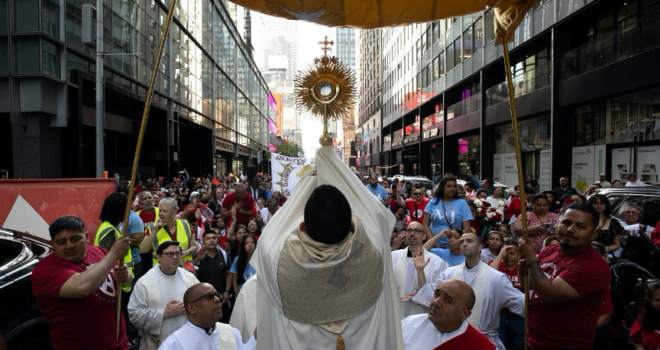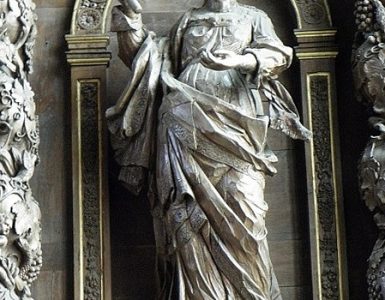
During this time of Eucharistic Revival, many are reflecting on how to make this time truly transformative in order for faith to be restored in the Real Presence of Jesus in the Holy Eucharist and ongoing Eucharistic Adoration to grow. Clergy, consecrated, and lay people have shared ideas of ways to rekindle devotion to our Lord in the Holy Eucharist.

- Learn how to pray the Mass with your heart
“When people go to Mass, they don’t know how to pray the Mass,” Fr. Matthew MacDonald, parochial vicar of St. Mary’s in Washingtonville in the Archdiocese of New York, shared. “So often people struggle with ‘how to lift up my heart and receive Him into my heart.’ Silent prayer, in addition to vocal prayer and devotion, help us in entering into His presence at adoration and in Mass.” Lectio Divina is one way to enter into deeper prayer that Fr. MacDonald, who is a frequent contributor at spiritualdirection.com, suggests.
To make the Eucharistic Revival truly take root, the faithful are called to “Make sure that whenever they go to Mass they prepare to go with intentionality, that they can bring before the Lord their life with the good, bad and ugly, their hopes and dreams,” he continued. “In the Holy Eucharist, Christ comes to us. We do that one thing necessary which is be at His feet like Mary or like John was at the Last Supper amid the turmoil, and at that is the Eucharistic Revival, allowing grace to be present to us.”
Citing Isaiah in reference to the Pharisees, Christ said that the people honored God with their lips are far from me (Matthew 15:8). We make sure to be close to Christ by “lifting up our hearts as the priest encourages us to do at every Mass before the Sanctus,” Fr. MacDonald explained, “and allowing Christ to lift up His Heart to us. How the faithful do that may vary, all are at different parts—some may have certain gifts or others are still struggling with sin and to grow in maturity, that is the beauty of the mystical body of Christ. What matters is you let Christ live in you through your Baptismal call—uniting your life to Him at consecration and receiving Him in Holy Communion. If we don’t, we won’t fully receive Him. There is always going to be a certain infinite mystery.”

2. Organize Eucharistic processions and pilgrimages
Msgr. Dennis J. Duprey, dean of the Clinton-Northern Franklin Deanery of the diocese of Ogdensburg, shared ideas inspired from the Eucharistic Congress in Auriesville, New York that may also be applied to other regions. “A lot of the things the Church does (for the Eucharistic Revival) will be removed from the people in local parishes. I certainly think that Eucharistic processions—maybe between Churches—are a good idea. I was struck that there were some thirty to fifty people of the diocese of Albany who had an El Camino-like pilgrimage. They walked up to Cohoes and walked up the river to Auriesville (45 miles away) over the course of a few days. They stayed at Churches and people’s homes. They walked the route together and prayed.
Speaking of his own area, Msgr. Duprey related, “We should do something like that. St. Isaac Jogues came right through the Champlain Valley here. Perhaps he even said Mass along the lake. They walked through our diocese. St. Kateri Tekakwitha fled that land (Fonda) because of persecution and went to Kahnawake (outside of Montreal) and through the Champlain Valley to do that. Maybe our diocese could have one of those walks from Rouses Point to Ticonderoga. It would bring something to young people.”
“We have a tradition of saints that walked through the Champlain Valley. All of them became saints because of their reverence for the Eucharist. Eucharistic processions bring the Eucharist to the people.”
Catholics in many other areas are also blessed to have special shrines or places of pilgrimage where they may follow in the footsteps of the saints and imitate their devotion to our Eucharistic Lord.

3. Imitate Our Lady and the saints’ Eucharistic devotion
St. Kateri Tekakwitha, known as the Lily of the Eucharist, rose before dawn and walked through the woods to the Church even in the bitterest winter. She would kneel outside in the snow and wait for the doors to open to spend time in Eucharistic Adoration. St. Kateri attended more than one Mass daily and, according to others, glowed when she received Holy Communion. It was her love of the Real Presence of Jesus that inspired her to give her life totally to Christ and spend herself in service to others.
“[Saint] Kateri felt called to the virginal life and today is recognized by the Church as a patroness of consecrated virgins. This love and desire for virginity was, in part, inspired by the Blessed Virgin Mary. According to one of Kateri’s biographers, Fr. Claude Chauchetière, ‘The virginity that Katharine [Kateri] always loved, that she preserved at the cost of her bodily life, was the reason of her frequent recourse to the Blessed Virgin; for she regarded her life as a model to be imitated as much as possible.’ She was so much in love with God that she wanted to dedicate her entire life to single-hearted devotion to our Savior.” (How They Love Mary: 28 Life-Changing Stories of Devotion to Our Lady, Fr. Edward Looney)
Lisa Lickona, who spoke about “The Eucharist in the lives of our American Woman Saints” at the Eucharistic Congress in Auriesville, described how St. Kateri was “riveted” by the Holy Eucharist as well as St. Elizabeth Ann Seton’s hunger for Holy Communion. She recalled how St. Frances Xavier Cabrini wrote: “You, Jesus, are in the Blessed Sacrament for me and for everyone, just as in the Host You are all in all, entire, even in each particle. Oh love, how can this be, You are for all people and yet give each individual Your whole attention.”
In his talk at Auriesville, Dr. Peter Kreeft – renowned Professor of Philosophy at Boston College and author of over one-hundred books, testified: “The meaning of life is to become a saint, but how? I think the two very best ways are these: first, to treat your neighbor as what he is, namely the body of Christ, to believe and practice Christ’s word ‘whatever you do to the least of these my brethren, you are doing to me.’ The other is to treat the Eucharist as what it is and do whatever it takes to receive daily or at least frequent Holy Communion and do frequent Eucharistic Adoration. These two things, loving your neighbor and loving Christ are what you will be doing in heaven forever.”

4. Give the faithful increased opportunities to encounter our Eucharistic Lord
Katie Prejean McGrady, a speaker, award-winning author, radio host and podcaster, spoke about how to cultivate love for the Holy Eucharist in families at Auriesville. “The way we grow Eucharistic love in our family is by going to Him, even if the kids are squirmy, even when they have lots of questions, even when they might feel distant and alone from the Lord, and saying ‘Lord, we are here and we want to know that you care, and hear Him call us by our name, grow in that intimacy and love in a way that transforms the world.” The example of her parents’ faith and their daily Mass attendance also impacted both her and her sister, who is now a postulant in a religious community.
The impressions of college students following the Eucharistic Congress in Auriesville is also something that we may learn from; we need these opportunities to “come away” from our routine lives and encounter our Lord with other faithful. Several members of the Newman Association at SUNY (State University of New York) in Plattsburgh attended the Eucharistic Congress and shared their impressions:
“(It) was a very eye-opening experience for me,” said Liam McCarthy. “Seeing nearly 8,000 brothers and sisters gathered for our Lord Jesus Christ was truly beautiful. My favorite experience from the trip was the (Eucharistic) procession. My heart and spirit filled with joy as we were singing hymns to the Lord, who was with us in the Eucharist. What I walked away with from this experience is a deeper love and interest in the Eucharist. The Lord, especially through this trip, has made it clear to me that he is truly present in the Eucharist, as the church fathers have always taught. As St. Ignatius of Antioch said ‘I have no taste for corruptible food nor for the pleasures of this life. I desire the Bread of God, WHICH IS THE FLESH OF JESUS CHRIST, who was of the seed of David; and for drink I DESIRE HIS BLOOD, which is love incorruptible’ (110 AD).”
Haleigh Wilson, a freshman and RCIA candidate, was also moved by the Eucharistic procession. “You were able to see thousands of people paying respect to Jesus. Before this event, I had only attended one adoration. The Eucharistic Congress really inspired me to want to start attending adoration more. As a member of RCIA, this experience makes me so excited to become part of the church and be able to take part in the Eucharist at mass. Being new to the faith and to the Catholic Church this was an experience that will stay with me forever.”

5. Allow the Presence of our Lord to revive the Church
Director of youth ministry and assistant director of Faith Formation in her diocese in Ogdensburg, New York, Anita Soltero has witnessed the faith of youth “on fire for their faith . . . (who) have a great devotion to Adoration and the Holy Eucharist.” Soltero served on the planning committee for the Eucharistic Congress in Auriesville and described it as “cleansing,” “the old being washed out and replaced with the new.”
“As I looked at the pictures of the crowd at the top of the hill,” she pondered how “the purpose of a “revival” is to “restore” something that has been lost or gone ‘out of fashion.’ The Church has been greatly damaged by the sex abuse scandal. Only Jesus truly present to us in the Holy Eucharist can repair that hurt and pain. As we move on from that period in church history, only the Eucharist can help us regain what we have lost. There are many people who ARE connected to our blessed Lord in such a deep way as shown to us by this great display of humanity (at the Congress). Their joy, their, hope, their devotion is what will help restore our Church. The young families and youth that were there WILL carry us through.”
“On another level, as I was reflecting on why we need a ‘revival’ and will this event help – it came to me that the answer was clearly YES – on both fronts. Yes, we need to REVIVE Eucharistic devotion and YES this event will help. It will help because the strength gained from the blessings obtained just by being present, are enough to help the faithful not be afraid to speak about it. There was a plaque in the gift shop that read: ‘Let your faith be bigger than your fear.’ I bought it and it will sit right on my desk as a reminder not just of the 3 days spent in Auriesville in the cold and damp with thousands of faithful pilgrims, but as a reminder to me as well to ‘Be not Afraid.’ Be not afraid to share our faith in whatever way we can . . . .To be the face of Jesus to someone who just wants to be in His presence, and to never let yourself be far from Him, to receive Him in the Holy Eucharist as often as you can. To sit and gaze at Him in Adoration giving thanks always for what He has done and will always continue to do in the world. We have the job of bringing Christ to others through our words and deeds, and we cannot do it alone, we cannot do it without Him – ever present to us not just in Holy Eucharist, but in His people, His church.”
“That’s what is so important about the Eucharistic Revival – making that CONNECTION to Jesus. Once you have that, you have it for life.”

6. Restore Eucharistic reverence, restore society
Reverence for the Holy Eucharist also needs to be restored, shared Fr. Justin Maria Cinnante, O.Carm., of Transfiguration Parish in Tarrytown, New York. “The importance of reverence, and Eucharistic discipline” is something that he recently spoke about in a homily in Manhattan, following the desecration of a Sacred Host. “Catholics need to pray in reparation to the Eucharistic Lord for sacrileges committed against Him. People aren’t even taught anymore about the Eucharistic fast, making sure you’re receiving in a state of grace, and receiving reverently.” Some people show this by kneeling when receiving Holy Communion or receiving on the tongue, Fr. Justin added. Attention should also be given on showing how to properly purify the vessels and how Eucharistic ministers should bring Communion to the sick. People also need to be taught “who can receive, if you are prepared. Catechesis and the way the liturgy is performed is so important—the whole idea of preparation as well, especially if our Lord isn’t being honored as he should be. Reparation Masses and adoration for sacrilegious Communions (are important) also. I offer Mass in reparation for any sins committed against His Real Presence.”
“We cannot understate the challenges we face,” spoke Supreme Knight Patrick Kelly in his talk at Auriesville, “yet we cannot overstate the power of the Eucharist.” Speaking also of widespread depression, especially among our youth who come from broken homes, Kelly added, “Yes, the crisis of fatherhood is big and getting bigger, but Christ in the Eucharist is so much more powerful. Only He can save our families and society.”

7. Begin or increase Eucharistic Adoration in your area
Fr. Justin Maria brought a group of about twenty students from Iona Preparatory School in New Rochele where he serves as a chaplain to the Eucharistic Congress in Auriesville. He reflected, “Every Thursday, we have Adoration at school. Students and parents come to pray. They sign-up to pray for the students and community there. We have Adoration on a weekly basis, something to do to support the revival in New York State. It is the gift of Eucharistic devotion, evangelization, the sacraments and three years of preparation to encourage the faithful to keep going. Not just three years and done. I’m hoping that this will inspire a lot more Adoration chapels.
“My idea is that a diocese would have 40 hours of adoration from parish to parish. There would be Perpetual Adoration (by working together) from parish to parish. If each parish could organize it throughout the year, there would be different parishes involved. So, there is constantly that devotion to the Eucharist. It is practical, because every parish could get parishioners to sign up for Adoration. It could be organized on a diocesan level, keeping it going from place to place.”
Praying in the beautiful St. Kateri chapel where the 40 Hours of Eucharistic Adoration was held at Auriesville, I noticed that to the left of the monstrance was a painting of St. Isaac Jogues and underneath it read “The blood of the martyrs,” and to the right of the monstrance was a painting of St. Kateri Tekakwitha with the caption “is the seed of Christians.” St. Kateri is a model for all of us. As Most Rev. Terry R. LaValley, Bishop of Ogdensburg, said in his homily at the Eucharistic Congress on October 21, “The Lily of the Mohawks, all our North American Martyrs, the communion of Saints, have shown us what love can do. Their love, their encounter with the Eucharistic Christ empowered their mission mindedness in the face of real opposition.” His Excellency summoned the faithful to be “mission minded” in order to make the Eucharistic Revival truly effective. “God is love, my sisters and brothers. If we want to know what love is, we’ve got to know God intimately. I couldn’t help but think as the Blessed Sacrament was exposed in front of this high altar before the crucified one … if you want to know love, spend time gazing on the crucified one and the Real Presence in the tabernacle.”












